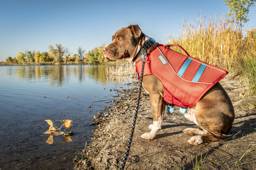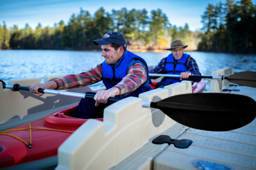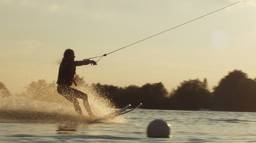
Is there any surer sign that the boating season has arrived than when you stand at the end of your dock and watch a runabout zoom by pulling happily shrieking kids on an inflatable tube that resembles a neon-colored starship? Not in my book.
This is the perfect time for a refresher on the dos and don’ts of towing a water toy behind your boat. Trust me, seeing the smiles on your kids’ or grandkids’ faces is well worth the price of a little precaution.
The first thing to remember is that, while thrills and spills are part of the scene, safety should always come first. If there’s a boater on hand who’s experienced in watersports, let him or her supervise things. If your whole crew is new to the game, be sure to take extra care. The good news is that tubing is among the easiest of all boating activities and can be great fun for the whole family.
See also Fueling Up Your Cabin Boat
Know Thy Tube
Not so long ago most towables were of the giant donut variety. But today’s inflatable water toys come in all shapes and sizes. Familiarize yourself with the tube and its capacity before you hit the water. Also be sure you know the recommended riding position – to maximize fun and safety. Some tubes are made for sitting, some for kneeling and some for lying flat on your stomach.
Are You Well Connected?
One of the most important safety considerations is the connection between the tube and the boat. Don’t forget to inspect the tow points on the tube for wear and tear, and use a towrope suitable for the job, like polypropylene, which floats so it won’t get caught in your boat’s propellers. If either the tube or rope is damaged, replace it before using. Attach the rope to your boat’s tow eye, ski pylon or water sports tower, not to cleats or hardware intended for other uses. They might pull loose, and you don’t want those snapping back toward your riders.
Driving the Tow Boat
It should go without saying that each rider must wear a Coast Guard-approved personal flotation device (PFD) regardless of riding and swimming ability. Remember that when it comes to hanging on to – and falling off of – a towable, your riders all have different levels of physical strength, endurance, awareness and skill. So as a driver you may need to make speed or driving adjustments accordingly throughout the day.
See also What You Need to Know About PFDs
Whoever is driving the boat is ultimately responsible for the safety of the riders. It’s wise for first-time drivers to practice pulling an empty tube around for a while to get the hang of it.
Discuss the towing route with your riders and plan your run to keep them out of high-traffic areas. Also, discussing hand signals for common communications like “ready,” “slow down” and “stop” is very important. These signals will be passed between the rider and the spotter, who then relays the message to the driver.
Before launch, ensure that the boat and tube are lined up. Next, don’t firewall the throttle right off the bat. This creates tremendous strain on the tow rope, tube and riders. Instead, move slowly through the water until the tow rope is tight and then speed up to a comfortable planing speed. Maintain a safe distance (at least 50 yards) from other boats, piers and floating platforms to prevent collisions. And use caution when making turns, since tube speed increases due to centrifugal force – and riders can be thrown off unexpectedly.
When driving the boat you should always follow the recommended speeds that come with your particular tube. As a general rule, you should keep speeds around 10 mph for beginners, 15 mph for intermediates and 20 mph for daredevils. Speeds over 25 mph are never a good idea.
Because the driver’s attention should always be on the water ahead, your boat needs a designated “spotter” to alert the driver if anyone falls off the tube and to keep track of that person’s location in the water. The spotter should hold up a red safety flag to let other nearby boaters know that a rider is down. (You can get one of these at most marine stores.) When it’s time to retrieve a rider, go slowly and carefully, and shut the engine off when you get close to the fallen rider.
Riders should signal that they are okay when they fall off a tube, and they should keep their hands in the air to increase their visibility.
Most of today’s tubes are designed to carry more than one person, which increases the fun but also adds more arms, legs and other body parts to the mix. It’s important for riders to stay a safe distance apart and distribute their weight evenly to balance the tube and keep it more stable while under way.
Sure, that’s a lot to remember when you’re zipping across the lake pulling a tube of adrenaline-crazed kids ... or adults. But as long as you start slow, use common sense and make safety a priority, you can rest assured that the shrieking coming from behind your boat will be music to your ears.










